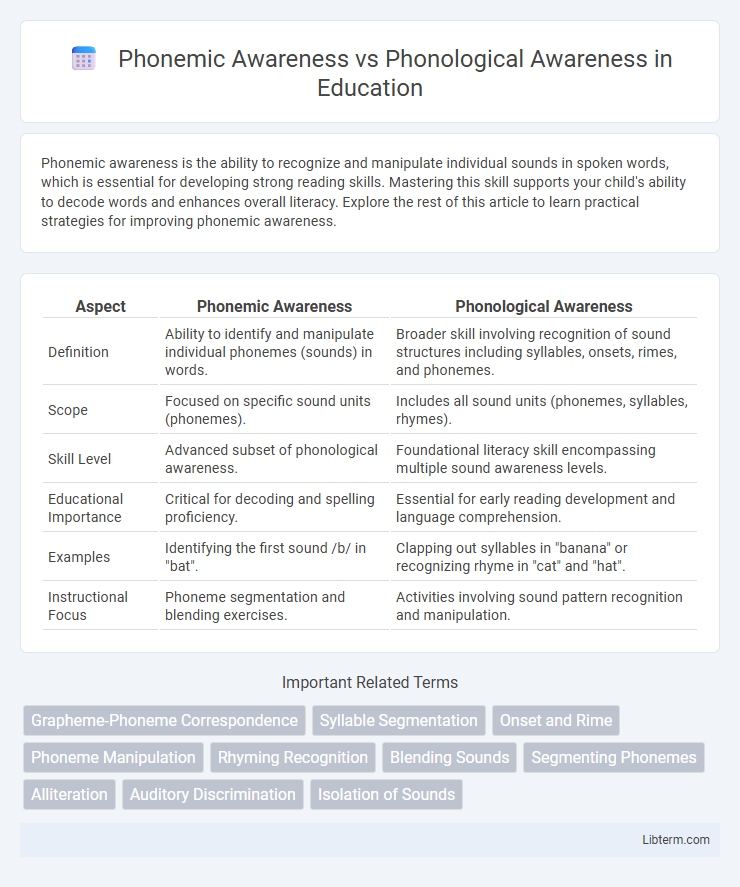Phonemic awareness is the ability to recognize and manipulate individual sounds in spoken words, which is essential for developing strong reading skills. Mastering this skill supports your child's ability to decode words and enhances overall literacy. Explore the rest of this article to learn practical strategies for improving phonemic awareness.
Table of Comparison
| Aspect | Phonemic Awareness | Phonological Awareness |
|---|---|---|
| Definition | Ability to identify and manipulate individual phonemes (sounds) in words. | Broader skill involving recognition of sound structures including syllables, onsets, rimes, and phonemes. |
| Scope | Focused on specific sound units (phonemes). | Includes all sound units (phonemes, syllables, rhymes). |
| Skill Level | Advanced subset of phonological awareness. | Foundational literacy skill encompassing multiple sound awareness levels. |
| Educational Importance | Critical for decoding and spelling proficiency. | Essential for early reading development and language comprehension. |
| Examples | Identifying the first sound /b/ in "bat". | Clapping out syllables in "banana" or recognizing rhyme in "cat" and "hat". |
| Instructional Focus | Phoneme segmentation and blending exercises. | Activities involving sound pattern recognition and manipulation. |
Understanding Phonemic Awareness
Phonemic awareness is the ability to identify and manipulate individual phonemes, the smallest units of sound in spoken language, essential for decoding words in reading development. It differs from phonological awareness, which encompasses a broader range of sound recognition skills such as rhyming and syllable segmentation. Mastery of phonemic awareness strongly predicts successful reading acquisition and is critical for effective phonics instruction.
Defining Phonological Awareness
Phonological awareness is the broad ability to recognize and manipulate sound structures in spoken language, including words, syllables, onsets, rimes, and phonemes. It serves as the foundational skill for learning to read and spell, encompassing all aspects of sound sensitivity beyond individual phonemes. This contrasts with phonemic awareness, a narrower skill focused specifically on identifying and manipulating phonemes, the smallest units of sound.
Key Differences Between Phonemic and Phonological Awareness
Phonemic awareness refers specifically to the ability to identify and manipulate individual phonemes, the smallest units of sound in spoken language, while phonological awareness encompasses a broader range of sound-related skills, including recognizing syllables, onsets, rimes, and rhymes in addition to phonemes. Key differences include the scope of sound units addressed--phonemic awareness is a subset of phonological awareness focusing exclusively on phonemes, which are critical for learning to decode words in reading. Research shows that explicit instruction in phonemic awareness is essential for early reading success, whereas phonological awareness forms the foundational skills needed for developing overall language and literacy abilities.
The Role of Phonemes in Reading Development
Phonemic awareness, the ability to recognize and manipulate individual phonemes, plays a crucial role in reading development by enabling children to decode words and understand letter-sound relationships. Phonological awareness encompasses a broader range of skills, including recognizing syllables, rhymes, and onset-rime, but phonemes are the essential units for mastering alphabetic principles. Strong phonemic awareness directly predicts reading success, as it supports decoding, spelling, and fluent reading.
Components of Phonological Awareness Skills
Phonological awareness encompasses a broad range of skills involving the ability to recognize and manipulate sounds in spoken language, including rhyming, syllable segmentation, onset-rime awareness, and phonemic awareness. Components of phonological awareness skills include identifying and producing rhymes, clapping out syllables, blending syllables and onsets/rimes, and segmenting words into individual phonemes. These foundational skills are critical for literacy development and differentiate from phonemic awareness, which specifically focuses on the manipulation of individual phonemes within words.
Importance of Phonemic Awareness in Early Literacy
Phonemic awareness, the ability to identify and manipulate individual sounds in words, is a critical skill for early literacy development and directly supports learning to decode words in reading. Unlike broader phonological awareness, which includes recognizing larger sound units like syllables and rhymes, phonemic awareness specifically targets phonemes, essential for understanding the alphabetic principle. Early mastery of phonemic awareness strongly predicts successful reading acquisition and helps prevent reading difficulties in young learners.
How Phonological Awareness Supports Language Acquisition
Phonological awareness encompasses a broad range of skills, including recognizing and manipulating larger sound units like syllables and rhymes, which lays the foundation for phonemic awareness focused on individual phonemes. This comprehensive understanding of sound structures enhances children's ability to decode words and build vocabulary, thereby accelerating language acquisition. Strong phonological awareness is linked to improved reading and spelling skills, crucial components in mastering oral and written language development.
Assessing Phonemic and Phonological Awareness in Children
Assessing phonemic awareness involves evaluating a child's ability to identify and manipulate individual sounds or phonemes within words, such as segmenting and blending sounds. Phonological awareness assessment encompasses a broader range of skills, including recognizing syllables, rhymes, and onset-rime patterns, which are crucial for early literacy development. Effective evaluation methods include tasks like phoneme isolation, syllable counting, and rhyming exercises, providing valuable data to tailor instruction for improving reading and spelling competencies.
Effective Strategies for Teaching Phonemic and Phonological Awareness
Teaching phonemic awareness requires focused activities like phoneme segmentation, blending, and manipulation to help students identify and work with individual sounds in words. For phonological awareness, strategies include rhyming games, syllable clapping, and sentence segmentation to develop the ability to hear and manipulate larger sound units. Utilizing multisensory approaches and explicit instruction enhances the effectiveness of both phonemic and phonological awareness interventions.
Common Misconceptions About Phonemic vs Phonological Awareness
Phonemic awareness is often mistakenly equated with phonological awareness, but phonological awareness encompasses a broader set of skills including recognizing rhymes, syllables, and onsets, while phonemic awareness specifically involves the manipulation of individual phonemes. A common misconception is that mastering phonemic awareness automatically implies strong overall phonological skills, yet children can develop some phonological awareness abilities without fully understanding phonemes. Educators should differentiate these concepts to effectively target early literacy interventions, as phonemic awareness is critical for decoding and reading proficiency, whereas phonological awareness supports a wider range of language processing abilities.
Phonemic Awareness Infographic

 libterm.com
libterm.com